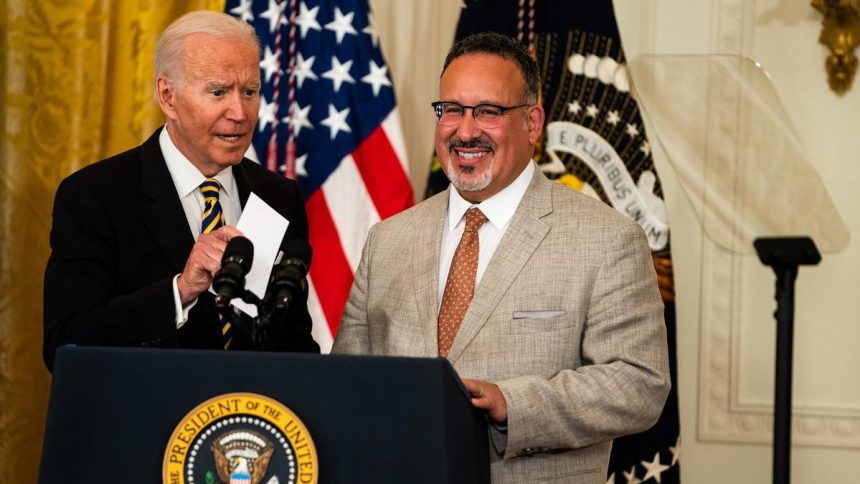The Biden administration is sending out a new batch of emails to borrowers potentially eligible for student loan forgiveness under a recent class action settlement. The Supreme Court recently rejected a challenge to that settlement, allowing the Education Department to move forward in implementing the student debt relief.
Here’s what borrowers should know.
$6 Billion In Student Loan Forgiveness Under Borrower Defense Settlement
The settlement agreement resolves Sweet v. Cardona, a years-long class action lawsuit brought by student loan borrowers over the Borrower Defense to Repayment program. That program can provide debt relief — including student loan forgiveness — for borrowers who were misled or defrauded by their school. The class of borrowers who filed the suit (originally against the Trump administration) had argued that the Education Department illegally delayed hundreds of thousands of application decisions, and arbitrarily denied other applications without adequate review.
The approved resolution of the suit would provide $6 billion in student loan forgiveness, as well as payment refunds and some credit report improvements for covered borrowers. Hundreds of thousands of borrowers who attended one of dozens of institutions approved under the agreement will qualify. The Supreme Court rejected a legal challenge last month seeking to halt the relief, paving the way for the Education Department to proceed.
Education Department Notifies Post-Class Applicants Of Settlement Process
Borrowers who submitted Borrower Defense to Repayment applications by June 22, 2022 and attended one of the approved schools are part of the “automatic discharge” group. Under the Sweet v. Cardona settlement, these borrowers are entitled to student loan forgiveness for their applicable federal student loans automatically. The Education Department has already notified most of these borrowers of their eligibility, and relief will be implemented throughout the remainder of this year.
Last week, the department began notifying “Post-Class Applicants” of their potential eligibility for debt relief under the settlement. A “Post-Class Applicant” is a borrower who submitted a Borrower Defense to Repayment application between June 22, 2022 and November 16, 2022, the date when the settlement agreement was approved by the court. Post-Class Applicants will not receive automatic student loan forgiveness, but are entitled to a formal determination on their Borrower Defense applications within three years. If the Education Department does not issue a decision, then at that point, the borrower could receive automatic student loan forgiveness.
“The Department of Education will apply the standards for borrower defense claims in the borrower defense regulations published by Department in 2016 to make a decision on your application no later than January 28, 2026,” says the department email received by Post-Class Applicants last week. “If the Department decides you are eligible for a discharge, you will receive the discharge no later than one year after that decision. If the Department does not issue a decision by January 28, 2026, you will receive a discharge of the federal student loans associated with your borrower defense application and a refund of any amounts paid to the Department on those federal student loans, and the credit tradeline for those loans will be deleted from your credit report.”
The department’s notice also states that borrowers who are in default on their associated federal student loans will not be subject to collections activity, such was wage garnishment or seizure of federal tax refunds, while their application is pending.
Next Steps For Borrowers Seeking Student Loan Forgiveness Through Borrower Defense
Although student loan forgiveness is not guaranteed, Post-Class Applicants under the Sweet v. Cardona settlement do not need to take any specific further action to potentially qualify. “You do not have to do anything,” says the Education Department email. “This notice acknowledges that the Department has received your application and identified you as a Post-Class Applicant under the Sweet settlement, and you do not need to take any additional action.”
Post-Class Applicants, and other borrowers potentially covered by the Sweet v. Cardona settlement, can learn more about the settlement details via the Project on Predatory Student Lending, the legal organization representing the class of borrowers in the case.
Borrowers not covered by the Sweet settlement, but who believe they were misled or defrauded by their school, can still submit an application to request Borrower Defense to Repayment relief; it just won’t be covered by the provisions of the Sweet settlement, and the Education Department will make case-by-case determinations of eligibility. The Biden administration recently published detailed new guidance for the Borrower Defense program designed to increase the chances that an application is ultimately approved.
Further Student Loan Forgiveness Reading
To Qualify For Student Loan Forgiveness Under Adjustment, Do These Things, Says Education Department
GOP Targets These Student Loan Forgiveness Plans As Debt Limit Standoff With Biden Escalates
What The Supreme Court’s Latest Move Means For Student Loan Forgiveness
4 Critical Student Loan Forgiveness Dates Borrowers Should Know About
Read the full article here


